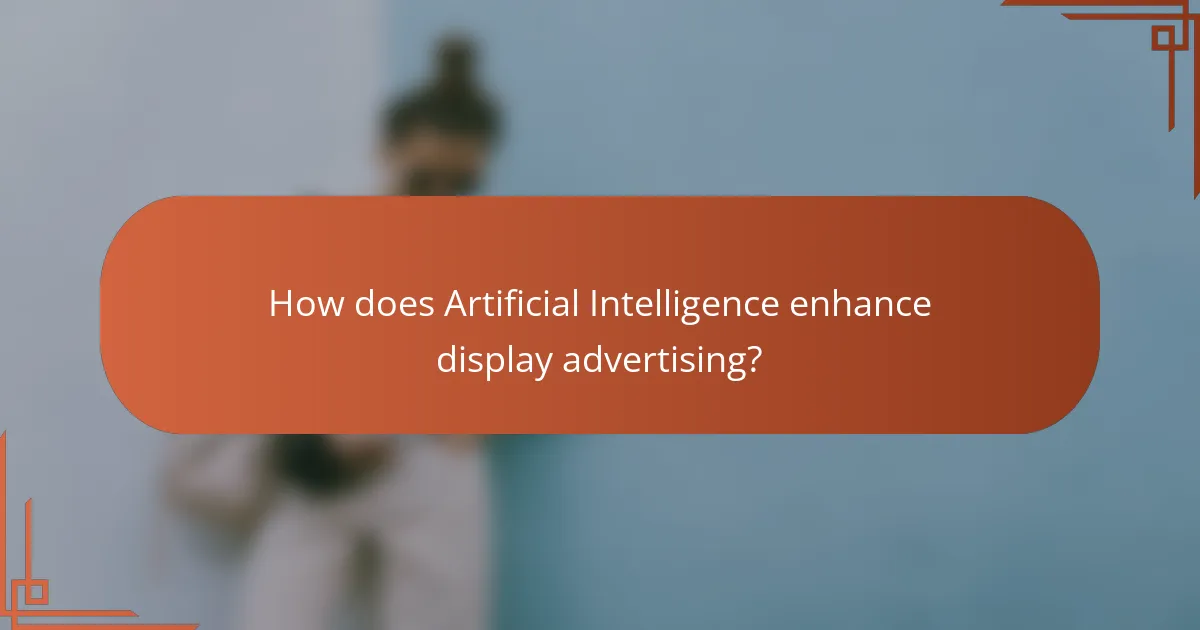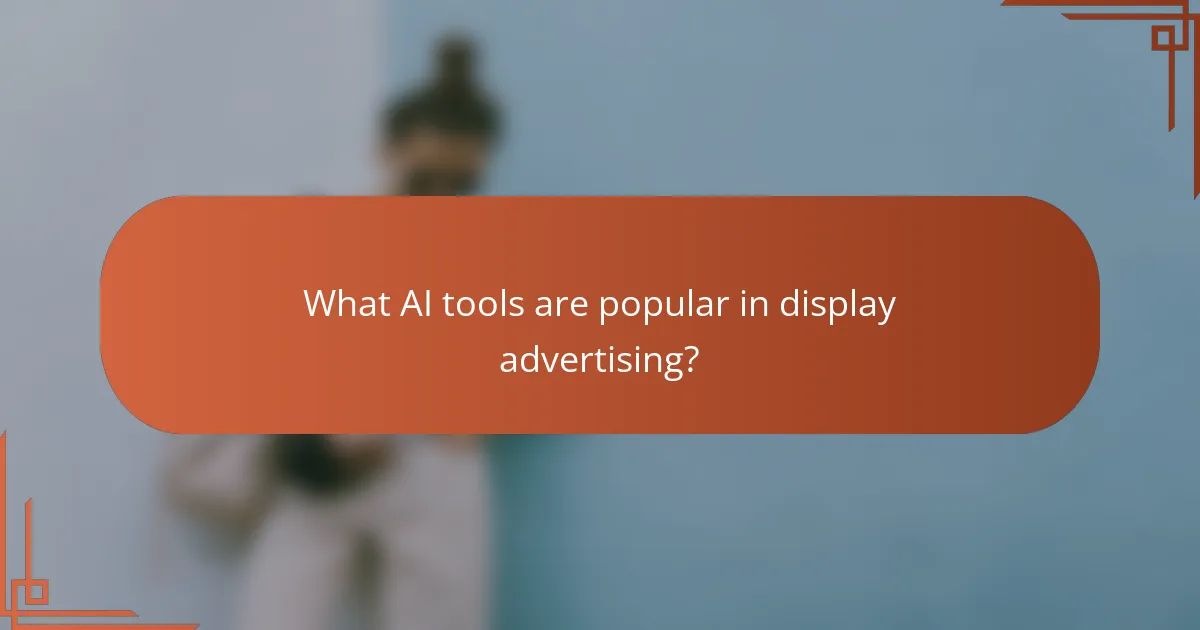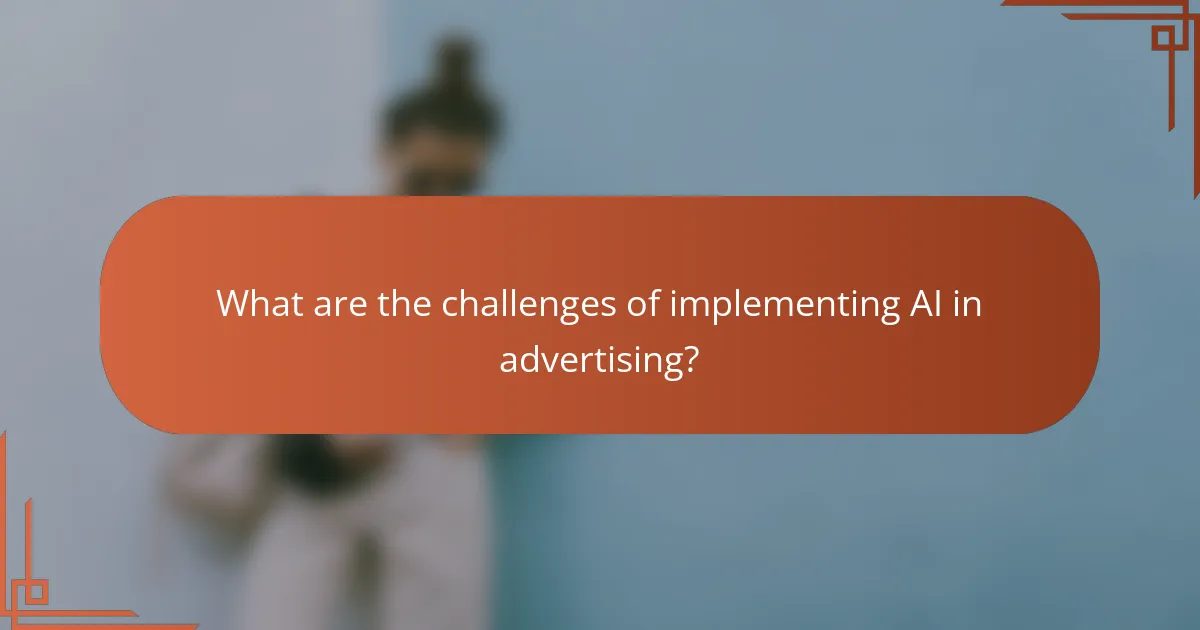Artificial Intelligence (AI) is revolutionizing the landscape of display advertising by enhancing targeting precision, streamlining automation, and optimizing ad placements. These innovations not only deliver more relevant advertisements to users but also maximize return on investment for advertisers. By leveraging advanced data analysis and machine learning, AI tools empower businesses to refine their marketing strategies and achieve superior results with greater efficiency.

How does Artificial Intelligence enhance display advertising?
Artificial Intelligence (AI) significantly enhances display advertising by improving targeting precision, increasing automation efficiency, and optimizing ad placements. These advancements lead to more relevant ads for users and better return on investment for advertisers.
Improved targeting precision
AI enhances targeting precision by analyzing vast amounts of data to identify user behaviors and preferences. This allows advertisers to create highly personalized ads that resonate with specific audience segments, increasing engagement rates.
For example, AI algorithms can segment audiences based on demographics, interests, and online behavior, enabling advertisers to tailor their messages effectively. Utilizing machine learning, these systems continuously refine targeting strategies based on real-time data, ensuring that ads reach the most relevant users.
Increased automation efficiency
Automation powered by AI streamlines the ad creation and management process, reducing the time and resources needed for campaign execution. Automated systems can handle tasks such as bidding, ad placement, and performance monitoring without constant human intervention.
This efficiency allows marketers to focus on strategic planning and creative development rather than routine tasks. By leveraging AI, advertisers can quickly adapt to market changes and optimize campaigns on the fly, enhancing overall productivity.
Optimized ad placements
AI optimizes ad placements by determining the best channels and times to display ads based on user engagement patterns. This ensures that ads are shown when they are most likely to be seen and acted upon, maximizing visibility and effectiveness.
For instance, AI can analyze historical performance data to predict which platforms yield the highest conversion rates for specific demographics. Advertisers can then allocate budgets more effectively, focusing on high-performing placements and reducing spend on less effective channels.

What are the key benefits of AI in advertising?
AI in advertising offers significant advantages, including cost efficiency, improved engagement, and enhanced data analysis. These benefits enable businesses to optimize their marketing strategies and achieve better results with fewer resources.
Cost reduction
AI can significantly lower advertising costs by automating repetitive tasks and optimizing ad placements. For instance, machine learning algorithms can analyze past campaign performance to determine the most effective channels, reducing wasted spend.
By leveraging AI, companies can also minimize the need for extensive manual labor, allowing teams to focus on strategic planning rather than execution. This shift can lead to overall savings of 20-30% in marketing budgets.
Higher engagement rates
AI enhances engagement rates by personalizing content and targeting specific audiences more effectively. By analyzing user behavior and preferences, AI systems can deliver tailored advertisements that resonate with individual consumers.
For example, dynamic ad content can change based on real-time data, increasing the likelihood of interaction. Businesses may see engagement rates improve by 10-50% when utilizing AI-driven strategies compared to traditional methods.
Real-time data analysis
AI facilitates real-time data analysis, allowing advertisers to make quick, informed decisions. This capability enables brands to adjust campaigns on the fly based on current performance metrics, ensuring they remain relevant and effective.
Utilizing AI tools can provide insights within minutes, compared to traditional methods that may take days. This immediacy helps businesses stay competitive and responsive to market changes, ultimately improving campaign outcomes.

What AI tools are popular in display advertising?
Popular AI tools in display advertising include platforms that leverage machine learning to optimize ad performance and targeting. These tools help advertisers automate processes, enhance targeting precision, and improve overall campaign efficiency.
Google Ads AI features
Google Ads incorporates various AI features designed to enhance ad targeting and performance. Smart Bidding, for example, uses machine learning to optimize bids for conversions or conversion value in each auction, adapting in real-time based on data signals.
Additionally, Responsive Display Ads automatically adjust their size, appearance, and format to fit available ad spaces, maximizing reach. Advertisers can input multiple headlines and descriptions, allowing Google’s AI to test combinations and find the most effective ones.
Adobe Advertising Cloud
Adobe Advertising Cloud utilizes AI to streamline ad management across multiple channels. Its AI capabilities include audience targeting, where machine learning analyzes user behavior to identify high-value segments, allowing for more effective ad placements.
The platform also offers predictive analytics, helping advertisers forecast campaign performance and optimize budgets accordingly. By leveraging data from various sources, Adobe’s AI can provide insights that enhance decision-making and campaign strategies.
Facebook Ads Manager AI
Facebook Ads Manager employs AI to improve targeting and ad delivery. Its machine learning algorithms analyze user interactions and behaviors to optimize ad placements, ensuring that ads reach the most relevant audiences.
Features like Automatic Placement allow Facebook to decide where to show ads across its platforms, maximizing exposure and engagement. Advertisers can also use dynamic ads, which automatically show the right products to users based on their interests and previous interactions.

What are the challenges of implementing AI in advertising?
Implementing AI in advertising presents several challenges, including data privacy concerns, high implementation costs, and skill gaps in the workforce. Addressing these issues is crucial for successful integration and maximizing the benefits of AI technologies.
Data privacy concerns
Data privacy is a significant challenge when implementing AI in advertising, as it often relies on collecting and analyzing large amounts of personal information. Advertisers must navigate regulations such as the GDPR in Europe and CCPA in California, which impose strict guidelines on data usage and consumer consent.
To mitigate privacy risks, businesses should adopt transparent data practices and ensure compliance with relevant laws. This may involve anonymizing data, obtaining explicit consent from users, and implementing robust security measures to protect sensitive information.
High implementation costs
The costs associated with implementing AI in advertising can be substantial, encompassing technology acquisition, infrastructure upgrades, and ongoing maintenance. Businesses may face initial expenses in the low tens of thousands of USD for software and hardware, along with additional costs for training and support.
To manage these costs, companies can consider phased implementation strategies, starting with pilot projects that demonstrate value before scaling up. Leveraging cloud-based AI solutions can also reduce upfront investments while providing flexibility and scalability.
Skill gaps in workforce
A lack of skilled professionals in AI and data analytics poses a challenge for many organizations looking to implement AI in advertising. The demand for expertise in machine learning, data science, and AI strategy often outpaces supply, leading to difficulties in finding qualified candidates.
To bridge this skills gap, companies can invest in training programs for existing employees, partner with educational institutions, or consider outsourcing AI projects to specialized firms. Encouraging a culture of continuous learning can also help teams stay updated with the latest advancements in AI technology.

How can businesses measure AI effectiveness in campaigns?
Businesses can measure AI effectiveness in campaigns by analyzing key performance indicators (KPIs) and employing attribution models. These metrics help determine how well AI-driven strategies are performing and their impact on overall campaign success.
Key performance indicators
Key performance indicators (KPIs) are essential for assessing the effectiveness of AI in campaigns. Common KPIs include conversion rates, customer engagement levels, and return on investment (ROI). By tracking these metrics, businesses can identify which AI strategies yield the best results.
When selecting KPIs, consider aligning them with specific campaign goals. For example, if the aim is to increase brand awareness, focus on metrics like impressions and reach. Regularly review these indicators to adapt strategies as needed, ensuring continuous improvement.
Attribution models
Attribution models are frameworks that help businesses understand the contribution of various marketing channels to campaign outcomes. These models can range from simple first-touch or last-touch attribution to more complex multi-touch attribution, which considers multiple interactions along the customer journey.
Choosing the right attribution model is crucial for accurately measuring AI effectiveness. For instance, multi-touch models provide a more comprehensive view, allowing businesses to see how AI influences different stages of the customer journey. Regularly revisiting and refining these models can enhance insights and optimize future campaigns.
